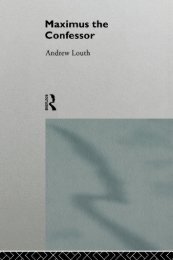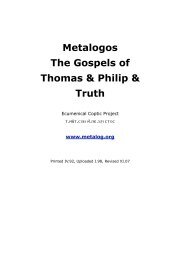Gospels of Thomas and Philip and Truth - Syriac Christian Church
Gospels of Thomas and Philip and Truth - Syriac Christian Church
Gospels of Thomas and Philip and Truth - Syriac Christian Church
You also want an ePaper? Increase the reach of your titles
YUMPU automatically turns print PDFs into web optimized ePapers that Google loves.
as the original Gospel Messianics were eventually supplanted by the<br />
Pauline ‘<strong>Christian</strong>s’ (Ac 11:2526). Thus the Epistle <strong>of</strong> Barnabas (late first<br />
century) remains unacquainted with the historical <strong>Gospels</strong>, whereas Justin<br />
Martyr (mid-second century) shows no awareness <strong>of</strong> Paul's writings—<br />
indicating an ongoing schism between the Petrine <strong>and</strong> the Pauline<br />
traditions. Clement <strong>of</strong> Alex<strong>and</strong>ria <strong>and</strong> Irenaeus <strong>of</strong> Lyon, at the end <strong>of</strong> the<br />
second century, are the first authors explicitly to quote from both the<br />
<strong>Gospels</strong> <strong>and</strong> from Paul. I have attempted to analyze the basis <strong>of</strong> this rift<br />
in ‘The Paul Paradox’, Comm.5, below. Essential reading on that formative<br />
period is Walter Bauer's pioneering study, Orthodoxy <strong>and</strong> Heresy in<br />
Earliest <strong>Christian</strong>ity (1934; http://ccat.sas.upenn.edu/humm/Resources/Bauer).<br />
The translations <strong>of</strong> the texts themselves are both as literal <strong>and</strong> as<br />
lyrical as I could make them. Any grammatical irregularities encountered<br />
(e.g. the verb tenses in Th 109) are in the Coptic text itself. Plausible<br />
textual reconstructions are in [brackets], while editorial additions are in<br />
(parentheses). ‘[...]’ indicates places where it is not possible to<br />
interpolate the deterioration <strong>of</strong> the papyrus manuscript. The Greek<br />
Oxyrhynchus variants to <strong>Thomas</strong> are within {braces}. ‘You’ <strong>and</strong> its<br />
cognates are plural, ‘thou’ <strong>and</strong> its cognates represent the singular (but<br />
generally with the modern verb-form). Notes at the end <strong>of</strong> each logion<br />
are indicated by superscript¹, those at the end <strong>of</strong> the current text with a<br />
circle°. The scriptural cross-references listed are essential to an<br />
underst<strong>and</strong>ing <strong>of</strong> the saying in its biblical context, <strong>and</strong> the reader is urged<br />
to refer to them in every case; explicit parallels to <strong>Thomas</strong> in the<br />
Synoptics are separately marked with an equal sign=, to spare the reader<br />
looking up what is already well-known. In antiquity, <strong>of</strong> course, there were<br />
no lower-case letters, <strong>and</strong> thus in order to represent the Hebrew, Greek<br />
<strong>and</strong> Coptic scripts I have not here used their subsequent cursive letters<br />
but rather their classic forms, which are easier for the non-scholar to<br />
read. In turn, in translating such ancient texts to modern languages, it is<br />
virtually impossible to capitalize in a consistent <strong>and</strong> adequate manner; I<br />
7




